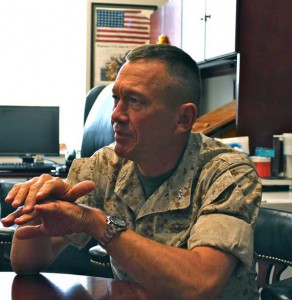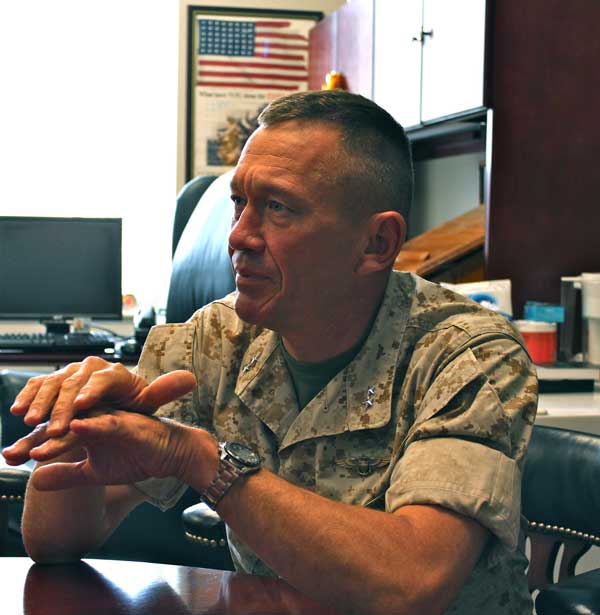10/04/2011 – During an interview at Cherry Point Air Station, the Commanding General of the 2nd MAW continued an earlier conversation on the evolution of the Amphibious Ready Group. We had discussed earlier the emergence of the “newly enabled ARG” and its impact on the nation. Here the CG discussed the ground being prepared for the new USMC pilots, or the “iPad generation pilots,” as we have referred to them.

General Davis discussed the flexibility and significance of the Amphibious Ready Group and the MEU structure to the Marine Corps and the Nation. The General referred to the MEUs has having a “job jar” for each deployment and that “job jar” has of late turned out to be very different each time they set sail.
But because of the inherent flexibility of the ARG, they like no other combat structure are ready to handle the wide variety of mission sets the Combatant Commanders have asked them to take on. In many ways the MEU’s “job jars” can be shaped on the fly (vice being stuck with a preset and rigid mission structure).
The CG of the 2nd MAW has significant experience with the aviation elements, which are helping shape a newly enabled ARG, and he discussed the impact of these new systems — today. The capability of the ARG is being reshaped under the influence of the Osprey now, and will be even more so with the F-35B in the near future.
The Marine Corps, whether we’re maneuvering (from) forward operating bases ashore or maneuvering (from) sea bases afloat is an immensely valuable force. The Combatant Commanders keep asking for more of what we produce for deterrence and combat operations – in every corner of the globe. Marine Forces are so utilitarian, offer such strategic agility, and can be very readily tailored to be right sized for the task at hand – that our demand signal is way up. From my vantage point, it seems like we need more of what we deliver – and will need even more in the future … and we’re procuring the kind of equipment that allows us to sustain and exponentially improve upon our capability to do that in the future, and I would contend deliver a lot of bang for the buck.
General Davis discussed the impact of the Osprey in terms of speed and range and the operational flexibility of the Osprey for current operations.
The Osprey allows the warfighter to influence operations over a vast chunk of real estate at speeds and ranges twice that of conventional helicopters – the operational and strategic significance of this capability should not be unappreciated. Your ability to influence from a sea base or to maneuver ashore is expanded significantly with this plane. And when you team the Osprey with the F-35B, you will be able to provide significantly greater combat capabilities – and options – to the Combatant Commanders.
For example, the bad guys could look at Libya and conclude: Look at what the V-22s did to us in Libya; we are going to develop air defense systems that will deny the Marines the ability to use that plane to the strategic and operational advantage they displayed in 2011. But with the F-35 escorting that airplane, it will be able to expand where it the Osprey goes and under what conditions. I will be able to go after an air threat, ground threat – and provide air-ground fires deep in the enemies battlespace in support of MV-22 operations – and do all that from a large deck amphibious ship. We are just scratching the surface of what the MV-22 can do and when we can combine them with the F-35 –its the envelope will only expand….
Another aspect of the impact of the MV-22 on operations was underscored in the recent 26th MEU operations.
We were able to use the Osprey as a logistical enabler for the MEU at sea. This will allow you to leverage the value of the deployed fleet because you can actually leverage a distributed fleet to move critical material around the fleet in operation.
Just two days ago we saw a MV-22 deliver a Harrier engine from the supply ship over to a big deck and that hadn’t been done before. We have always done it with CH-53s but our CH-53s have pulled off of that ship to do another mission.
During the Libyan mission we flew the Ospreys to get parts and supplies which allowed us to sustain the ARG at longer ranges (four times what we were able to with a 46) – and at twice the speed – you can’t understate the operational impact of using this bird in a logistics role like that. In the end it makes deployed MAGTFs that much more agile and effective – and valuable to a Combatant Commander.
Another illustration of the flexibility, which the Osprey provides, is the ability to move the plane from one location to another rapidly to augment capability. For example:
When we moved the Ospreys from Afghanistan to rejoin the ARG, they flew directly from Afghanistan to Kuwait to Souda Bay, being tanked along the way, and did the flight in one day (in under 13 hours of flight time).
The Osprey allows provides significantly greater survivability for the Marines. I can fly to and from my objective area above the threat the primary threat. It’s very hard for the bad guys to predict exactly where the airplane is going or when it is going to come down on them. It is very quiet in plane operating mode – allowing us to move Marines and material quickly, quietly and operationally effectively.
Due to the speed, range, low noise signature and cruise altitudes – the bad guys have a hard time telegraphing where the airplane’s going to land. There is a capability that is hard to put a quantitative value on – but to me a lot of folks talk about game changers – this is a no bull — bonafide one.
The CG then discussed the shift associated with the F-35B.
My son is a Harrier pilot and the way we are operating our AV-8Bs off of the MEUs is a sea change from what we used before. In fact, there is absolutely no comparison to what we do today – and what we deliver for the Combatant Commander with our AV-8Bs as compared to what I could do in my AV-8B as a young attack pilot. I look at what they did during the 26th MEU and I am immensely proud of the capability we have developed and delivered to the Combatant Commanders.
The improvements in capability we have put into the AV-8B has changed the way the combatant commanders looks at the jet and more importantly, changed the way they look at Marine Expeditionary Units and the capabilities that they bring to bear. Deep, responsive precision strike capability – now we are getting ready to deploy them with AMRAAM….
And what we have coming in the F-35B as compared to an AV8-B is absolutely no comparison. It is absolutely, positively no comparison. This airplane is going to change the capability of the ARG exponentially – in a very significant and positive direction. It is going to change again how the combatant commanders look at the MEU, the efficacy and utility of amphibious ships, the overall benefit of the MAGTFs embarked aboard amphibious ships and the strategic importance of this capability as it relates to our national security strategy.
And we will be able to bring an electronic warfare capability off of the ARG with the F-35B. We have driven home the importance of electronic warfare for the USN-USMC team and not just at the high-end of the fight.
The CG emphasized the importance of the EW culture within the USMC, and to the Prowler community within the USMC.
The Prowler guys are some of the brightest guys in the USMC.
But the F-35B was going to provide the USMC aviator cultures in our Harriers, Hornets and Prowlers to coalesce and I think to shape an innovative new launch point for the USMC aviation community.
We are going to blend three outstanding communities. Each community has a slightly different approach to problem solving. You’ve got the expeditionary basing that the Harrier guys are bringing to you. You have the electronic warfare side of the equation and the high-end fight that the Prowler guys thing about and the coms and jamming side of the equation, which the Prowler guys think about. And you have the multi-role approach of the F-18 guys.
I think it is going to be a fantastic blending of not only perspectives but also attitudes. And what I really look forward to is not the old guys like me, but the very young guys who will fly this fantastic new capability. The older generation may have a harder time unleashing the power and potential of the new gear – the new capabilities. We might say “why don’t you do it this way” when that approach might be exactly the wrong thing to do from a capabilities standpoint.
My sense is the young guys will blend. We’ve already picked the first Prowler pilot to go be an F35 guy. He’s going to do great and he’s going to add perspective and attitude to the tribe down at Eglin getting ready to fly the jet that’s going to make a big impact on the F35 community.
I think it’s going to be the new generation, the newbies that are in the training command right now that are getting ready to go fly the F35, who are going to unleash the capabilities of this jet. They will say, “Hey, this is what the system will give me. Don’t cap me; don’t box me. This is what this thing can do, this is how we can best employ the machine, its agility its sensors to support the guy on the ground, our MEU Commanders and our Combatant Commanders and this is what we should do with it to make it effective.”


